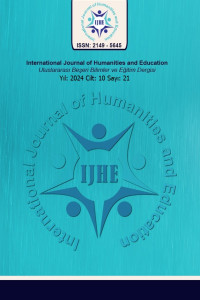Abstract
In this study, the wall paintings in the apse triumphal arch of the Kızıl Çukur valley and Üzümlü Church were examined in many aspects. The church is located in Kızıl Çukur, the valley between Ortahisar and Ürgüp. The Valley can be reached from Ürgüp by descending approximately 300 meters from the high elevation. The church is part of the monastery establishment. It has a special place in Byzantine painting with the "Christ on the Cross" scene located in the apse triumphal arch of the church. The article focuses on the architectural features of the building, as well as the depictions on the apse triumphal arch. There are five figures on the stage: Jesus, Mary, John the Baptist, John the Evangelist and St. Simon. In the study, detailed descriptions of the figures were made, their positions were determined on the painting surface, and the inscriptions on the stage were conveyed. The white handkerchief held by the Virgin Mary figure in the scene is emphasized as an important iconographic detail. The scene is dated by researchers to the "Archaic" period due to its iconography and stylistic features. The scene is iconographically different from other scenes in the region.
Keywords
References
- Thierry N. (2002). La Cappadoce de l’Antiquite au Moyen Âge, 2002, Paris. Umar, B. (1998). Kappadokia. Bir Tarihsel Coğrafya Araştırması ve Gezi Rehberi, Yaşar Eğitim ve Kültür Vakfı Yayınları, İzmir. Wharton, A. J. (1988). Art of empire: painting and architecture of the Byzantine periphery: a comparative study of four provinces. Pennsylvania State University Press. Zeitler, Barbara (1999). Desire and Denial in Byzantium: Papers from the thirty-first spring symposium of Byzantine Studies. University of Sussex, Brighton, March 1997. Sydney, Ashgate, 185-204.
Abstract
Yapmış olduğumuz bu çalışmada Kızıl Çukur vadisi, Üzümlü Kilise’nin apsis zafer kemerinde yer alan duvar resimlerini çok yönlü olarak incelenmiştir. Kilise Ortahisar ve Ürgüp arasında kalan vadi olan Kızıl Çukur da yer almaktadır. Vadi ’ye Ürgüp tarafından yüksek kottan yaklaşık 300 metre aşağıya inilerek ulaşılabilir. Kilise manastır kuruluşunun bir parçasıdır. Kilisenin apsis zafer kemerinde yer alan “Çarmıhta İsa” sahnesi ile Bizans resim sanatında özel bir konuma sahiptir. Makalede apsis zafer kemerindeki tasvirler ile birlikte yapının mimari özellikleri üzerinde de durulmuştur. Sahnede İsa, Meryem, Vaftizci Yahya, İncilci Yahya ve Aziz Simon olmak üzere beş figür bulunur. Çalışmada figürlerin detaylı tasvirleri yapılmış ve konumları resim yüzeyinde belirlenmiş ayrıca sahne de var olan yazıtlar aktarılmıştır. Sahnede Meryem figürünün elinde tutmuş olduğu beyaz mendil önemli bir ikonografik ayrıntı olarak vurgulanır. Sahne araştırmacılarca ikonografi, üslup özellikleri nedeniyle “Arkaik” döneme tarihlenir. Sahne ikonografik olarak bölgede yer alan diğer sahnelerden ayrılmaktadır.
Keywords
References
- Thierry N. (2002). La Cappadoce de l’Antiquite au Moyen Âge, 2002, Paris. Umar, B. (1998). Kappadokia. Bir Tarihsel Coğrafya Araştırması ve Gezi Rehberi, Yaşar Eğitim ve Kültür Vakfı Yayınları, İzmir. Wharton, A. J. (1988). Art of empire: painting and architecture of the Byzantine periphery: a comparative study of four provinces. Pennsylvania State University Press. Zeitler, Barbara (1999). Desire and Denial in Byzantium: Papers from the thirty-first spring symposium of Byzantine Studies. University of Sussex, Brighton, March 1997. Sydney, Ashgate, 185-204.
Details
| Primary Language | Turkish |
|---|---|
| Subjects | Historical Geography |
| Journal Section | Research Article |
| Authors | |
| Publication Date | April 30, 2024 |
| Submission Date | December 11, 2023 |
| Acceptance Date | February 12, 2024 |
| Published in Issue | Year 2024 Volume: 10 Issue: 21 |
International Journal of Humanities and Education (IJHE)
This work is licensed under a Creative Commons Attribution-NonCommercial-No Derivatives 4.0 (CC BY-NC-ND 4.0) International License.


